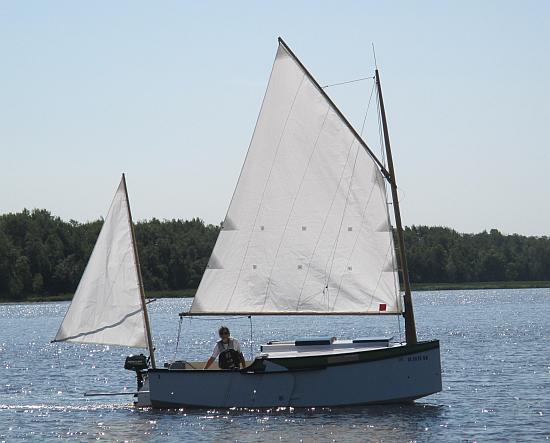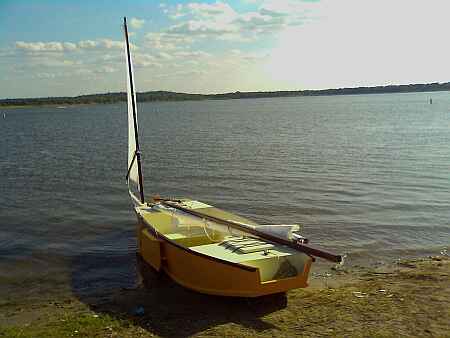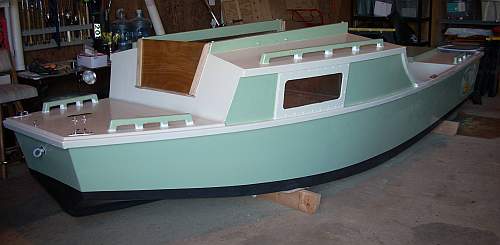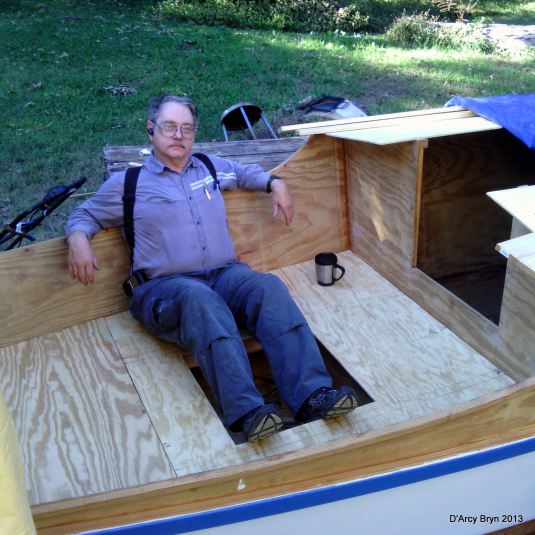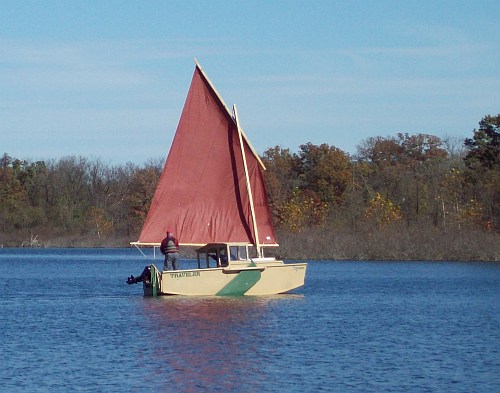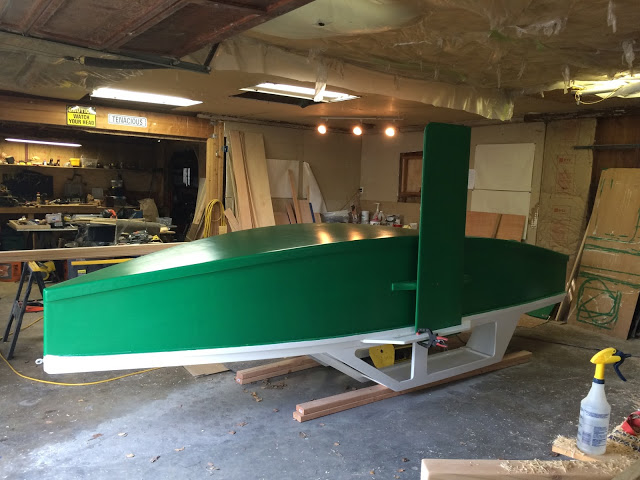Jim Michalak's Boat Designs
118 E Randall, Lebanon, IL 62254
A page of boat designs and essays.
(15 April 2016) This issue will look at aluminum spars vs wooden spars. The 1 May issue will scarf some lumber.
THE BOOK IS OUT!
BOATBUILDING FOR BEGINNERS (AND BEYOND)
is out now, written by me and edited by Garth Battista of Breakaway Books. You might find it at your bookstore. If not check it out at the....ON LINE CATALOG OF MY PLANS...
...which can now be found at Duckworks Magazine. You order with a shopping cart set up and pay with credit cards or by Paypal. Then Duckworks sends me an email about the order and then I send the plans right from me to you.
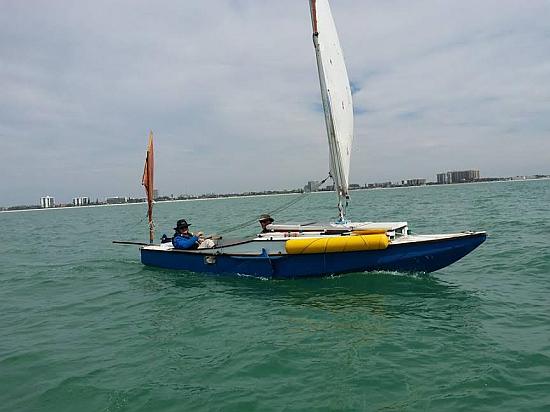 | Left:
Gary Blankenship and crew did well again in this year's EC300 using his old trusty Frolic2. |
|
Wood Vs Aluminum Spars
BACK TO THE DAYS OF YESTERYEAR....
...long long ago I had a third interest in a Hobie 16, my first boat. They were all the rage then. A very clever design. But I quickly found it ain't no one man boat, at least not for the young man I was then. I quickly moved on to a Snark Mach II which is very much a poor man's Sunfish. Truely a one man boat, slack bilges and about 3' wide, a shaped styrofoam block covered with a thin plastic shell like a big streamlined beer cooler. I suppose it weighed 80 pounds. It has 84 sq ft of nylon sail, more than the much heavier Sunfish, on aluminum spars. It was very low in the water and a very wet experience and I recall well the big waves and Carlyle Lake washing right over it at times. But I must say at times it would really fly. One day I sailed from the south ramp up and around the northern islands and back to the south ramp, 18 miles total, in three hours. It was reaching up and back in a perfect wind all on plane I guess. That sail, still the fastest I ever done certainly in a monohull, was as I recall quite effortless.
Later that year on Labor Day I got caught in a squall with it. Capsized and blown away from shore on a lake three miles wide, I hopped a watery ride with a Hobie crew that had also capsized so at least I wasn't alone. My Snark drifted away from us. The Hobie crew had a knowledgable skipper and the first order of action was to swim out to the mast tip and lash a spare life jacket there lest the boat turtle if the mast filled with water. Eventually we righted the Hobie right about the time the rescue arrived. The rescue boat had already rounded up my Snark and were relieved to find its skipper (me) was still alive. Two of the Hobie crew thought the experience was so cool that they did not accept a tow home. Instead they kept on sailing. As we who were rescued were brought back to the sail harbor we saw another rescue being towed in, a Y Flyer totally awash and floating almost totally below the surface to the point that I thought they were towing in a white sail, not a hull. The Flyer's rig was totally destroyed, nothing left above the deck.
I'm going to add a little more to this story. I recall when the storm was really bad that there seemed to be no "surface" to the water, just different densities of H2O from solid to mist in a gradual conversion about two feet thick. The next day my arms and legs were bruised all over. In general if I had not been rescued I think my life jacket would have sustained me until I fetched up on the other side of the wide lake. Without a life jacket there would have been no surviving it, at least not for me. So in a way it was a good learning experience I suppose.
MORE LESSONS LEARNED...
The Snark was rearranged by the storm. The rudder and daggerboard were totally gone, the plastic rudder cheek ripped right off the boat. The aluminum mast was bent a bit. The aluminum yard had lost the extension that plugs into its end which adds about two feet to the length. I called around for repair parts the next day and got the answer that the sailing season was over and the dealership closed. So I fixed it all myself. A new wooden daggerboard and rudder and new aluminum rudder cheek and yard extension. Hell, if I can fix this boat I can make my own from scratch, right? So it was a life changing storm in a way although I'm sure making my own boat was inevitable.
ON TO THE BOLGER TEAL...
By this time I had learned about Phil Bolger and had a copy of The Folding Schooner and made a Teal from the plans in that book. Like many of you I went to tinker with the details, something Phil never seemed to mind. As I recall the Teal hull was per plans but I decided that low tech wooden mast needed updating. Wicks Aircraft Supply is close to here and I knew from fixing the Snark that they had all sorts of aluminum tubing in stock. The thing is that you can't really replace a tapered wooden mast straight off with aluminum tubing because you can't get tapered tubing. Even flagpoles, which appear to be tapered, are I think rolled from a uniform tubing such that they are thicker at the narrow tip than at the wide base. So the taper is in appearance only, the weight of the tubing is the same per foot along the entire length. The weak point of the mast is at the base. That is where a wooden mast usually breaks and that is where the Snark mast got bent (just a little bit, I still used it). Besides, Wicks didn't stock aluminum tubing in long lengths, maybe10' max. So I dreamed a dream to telescope a smaller tip tube into the top of the larger base tube. Hey!, while I was at it I dreamed a dream to make it telescope with a halyard so I could reef the sail by shortening the mast!
So you pull on the halyard rope, it runs over a pulley through a slot in the top of the base section then back down to the bottom of the tip section, and the tip section telescopes out of the base like magic. Did it work? Yes it did. I still have it out in the shop even though the Teal hull was sold off long ago (with a wooden mast). I fear Bolger never bought into it since he loved simplicity. After I sold the Teal I used the magic mast on my Bolger Jinni until I got the real Jinni wooden mast done. But I never used another aluminum spar for several reasons, maybe none of them are good. One thing was the aluminum spars were surprisingly noisy and cold. Not a very good reason I know. But let's look at some number details and I'll admit I am doing this for the first time ever and know not how it is going to turn out.
WEIGHT COMPARISON....
Let's dream up a 16' long typical mast. Let's say the wood version is 3" square at the base tapering to 1.5" at the tip. That is about .65 cubic feet of wood. Typical wood weighs about 30 pounds per cubic foot so you are looking at about 19 pounds of wood.
Now let's figure an aluminum tube doing the same job. Let's say it is 3" round with a wall thickness of say .060" (I'm guessing but you don't want really thin and really thick is overkill (we will check that soon)). That stuff weighs .7 pounds per foot for a total of 11 pounds. So it is lighter than the wood stick even though it isn't tapered.
COST...
A quick peak at Wicks Aircraft Supply website shows 3" x .065 wall tubing 6061 aluminum (good stuff) is over $11 a foot. So you are approaching $200 in mast material and that might not scare some folks.
STRENGTH...
Here we'll do a quick check of the bending strength of the mast at the base (where the maximum bending loads are in a free standing mast).
Getting out the old handbook (Jeez, I used to do this sort of thing for a good living) I see good wood might have a breaking strength of say 5000 psi although it varies an awful lot. Now, the bending stress of an elastic beam is supposed to be stress=Mc/I where M is the bending moment (we're going to figure it), c is the distance from the "neutral axis" to the "extreme fiber" which in this case will be the outer edge of the wood which is 1.5" from the center of the mast, and I is the "moment of inertia" of the section. The I for a square like this mast is 1/12 width to the fourth power, or 6.76 inches to the fourth for this 3" square mast. Rearranging to solve for the M when the stress at the extreme fiber is 5000 psi gives us a bending moment at failure of M=5000x6.75/1.5 = 22500 inch pounds.
Now for the dream aluminum mast. Same system but here the max allowable stress for 6061-t6 aluminum is 35000 psi (keep an eye on this if you buy aluminum since untreated aluminum might be no stronger than good wood). The moment of inertia of the tube section is I = Pi x Rcubed x thickness which for our dream mast would be 3.14 x .06 x 1.5^3 = .64 inches to the fourth. So the bending moment in this tube when the stress equals the 35000 psi max stress is M = 35000 x .64/1.5 = 15000 inch pounds. That is quite a bit less than the wooden mast but this aluminum mast is also quite a bit lighter. So one might increase the wall, if it could be purchased, to .06 x 22500/15000 = .09 inches to get equal strength, and then the weight would go up about the same ratio to about 16 pounds. Then these two are getting pretty equal in strength and weight. Interesting. Now the aluminum guy will say he can get stronger aluminum and then the wood guy will say he can get stronger wood and I will leave the room as they argue.
STIFFNESS...
Here I would expect the aluminum mast to dominate but we can check that quickly to a certain degree. The stiffness of a beam like a mast is proportional to the its EI. I is the moment of inertia that we already calculated. E is the "modulus of elasticity" of the given material. To measure the E you take a stick of the material, put it in a big testing machine (like the one used to kill Vincent Price in the original "The Fly") and pull the stick apart until failure all the time measuring how much it stretches. For most of the experiment the stretch measured will be proportional to the load applied. So maybe 1000 pounds applied stretches it .001 inch, then 2000 pounds gives .002 stretch, and so forth. Eventually most materials get "soft" just before they break and the stretch gets out of hand, a very useful trait in some structures where you want a bit of warning before they collapse. E is a big number. For example if the above loads were applied to a 10" long stick with 1 sq in of cross section and it stretched .001" it would have an E of 1000/(.001x10) = .1 million psi. The value of E for wood varies a lot from stick to stick but my handbook thinks it is about 2 million for southern pine or fir. The E for aluminim is 10 million and it is interesting that the E for metals does not change from temper to temper as long as the metal has not been stretched beyond its elastic limit (after which it goes softer).
So the EI for the aluminum dream mast with a revised .09" wall would be 10E6 x .96 = 9.6E6.
The EI for the wooden mast would be 2E6 x 6.7 = 13E6. I'm surprised! The wooden mast would be stiffer than the aluminum except for one very important thing. The wooden mast is tapered towards the top and that greatly reduces its stiffness there since, as you recall, the I is a function of the width to the fourth power. So if it tapers from 3" to 1.5" at the top, the top would be just 1/16th as stiff as the bottom. The calculation of the deflection of a tapered beam is not at all simple and here I will leave it to the student.
WHAT'S IT ALL MEAN...
I guess it is a toss up. That is why you see masts both ways.
LAST COMMENT...
Remember that Hobie skipper? First thing he did in a capsize was to swim out to the masthead and lash a lifejacket there to keep it from sinking and turtle the boat. (Hey! I've never seen a real turtle swim upside down!) An aluminum mast must be sealed from water to prevent that and so it must be if you use a metal tubing mast. Don't take a chance.
Mayfly16
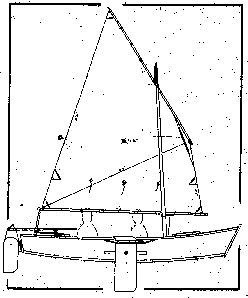
SAILBOAT, 15' X 5.5', 350 POUNDS EMPTY
Mayfly16 is large enough to swallow up three men or maybe a family with two kids. She has two benches that are 7' long and there should be plenty of room for all. I would say that her fully loaded maximum weight might be 900 pounds and her empty weight about 350 pounds, leaving 550 pounds for the captain and crew and gear.
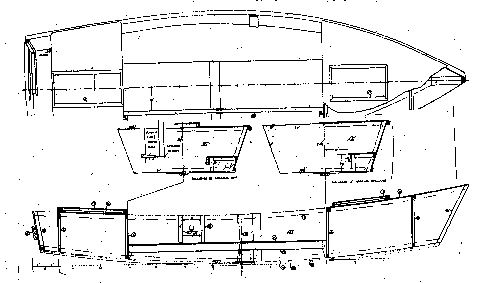
At the same time the Mayfly16 can easily be handled solo, although with just the weight of her skipper she will not be as stable as when heavily loaded. The boat also has two large chambers for buoyancy/storage and I can see her used as a solo beach cruiser because the floor space is large enough for a sleep spot. I've made her deep with lots of freeboard.
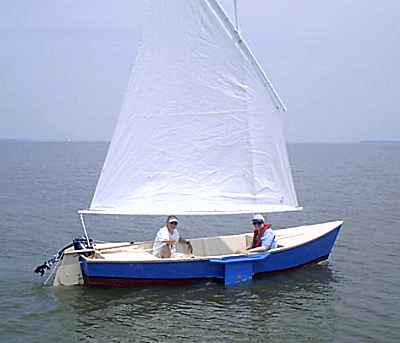
Mary and George Fulk built the prototype and passed by here with the prototype on their annual migration north for the summer and I had a chance to see and sail in Mayfly16 for a short bit. Weather was hot and the wind light and steady, perfect for testing. She sailed quite well I thought and everything worked as planned. It certainly was roomy and easy to rig and use.
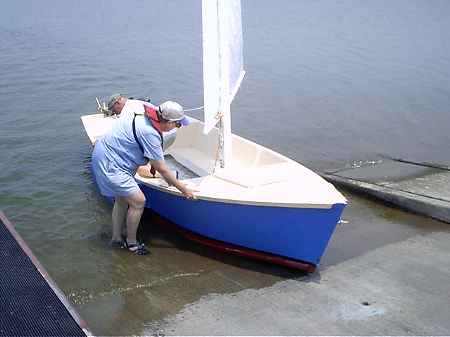
The balanced lug rig sets on short spars and sails very well reefed, in fact can be set up with jiffy reefing. The spars are all easily made and stowed, the mast being but 14' long setting 91 square feet of sail. In addition there are oar ports for those with lots of time and little money and a motor well for those with lots of money and no time. Two horsepower is all that a boat like this can absorb without going crazy.
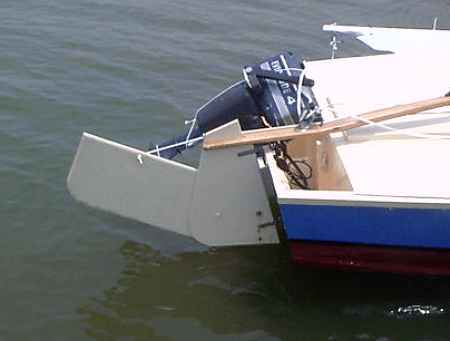
The motor well is an open self draining well that uses the full width and depth of the stern. It will come in handy for storing wet muddy things you don't want inside the boat, like boots and anchors. I've suggested in the plans that the rudder can be offset to one side a bit to give more room for the motor. We did not use George's little Evinrude since the boat sailed easily in all directions, but George says the sidebyside sharing on the stern of the motor and rudder works fine. There was no interference with the rudder. (As with any outboard on any sailboat, the motor has a desire to grab the sheet with each tack so you usually have to tend the sheet a bit.)
Mayfly16 uses conventional nail and glue construction needing six sheets of 1/4" plywood and two sheets of 1/2" ply.
Plans for Mayfly16 are $35.
Prototype News
Some of you may know that in addition to the one buck catalog which now contains 20 "done" boats, I offer another catalog of 20 unbuilt prototypes. The buck catalog has on its last page a list and brief description of the boats currently in the Catalog of Prototypes. That catalog also contains some articles that I wrote for Messing About In Boats and Boatbuilder magazines. The Catalog of Prototypes costs $3. The both together amount to 50 pages for $4, an offer you may have seen in Woodenboat ads. Payment must be in US funds. The banks here won't accept anything else. (I've got a little stash of foreign currency that I can admire but not spend.) I'm way too small for credit cards.
We have a Picara finished by Ken Giles, past Mayfly16 master, and into its trials. The hull was built by Vincent Lavender in Massachusetts. There have been other Picaras finished in the past but I never got a sailing report for them...
And the Vole in New York is Garth Battista's of www.breakawaybooks.com, printer of my book and Max's old outboard book and many other fine sports books. Beautiful job! Garth is using a small lug rig for sail, not the sharpie sprit sail shown on the plans, so I will continue to carry the design as a prototype boat. But he has used it extensively on his Bahamas trip towed behind his Cormorant. Sort of like having a compact car towed behind an RV.
And a Deansbox seen in Texas:
Another prototype Twister is well along:
And the first D'arcy Bryn is to the point the builder can sit and relax in it and imagine boating. You can follow the builder's progress at http://moffitt1.wordpress.com/ ....
The first Jukebox3 is on the (cold) water. The mast is a bit too short - always make your mast too long. A bit more testing will be nice...
A brave soul has started a Robbsboat. He has a builder's blog at http://tomsrobbsboat.blogspot.com. (OOPS! He found a mistake in the side bevels of bulkhead5, says 20 degrees but should be 10 degrees.) Letting the bottom paint cure as he goes on to the spars (it is upside down).
AN INDEX OF PAST ISSUES
THE WAY BACK ISSUES RETURN!
MANY THANKS TO CANADIAN READER GAETAN JETTE WHO NOT ONLY SAVED THEM FROM THE 1997 BEGINNING BUT ALSO PUT TOGETHER AN EXCELLENT INDEX PAGE TO SORT THEM OUT....
THE WAY BACK ISSUES
1may15, Boat Costs, Blobster
15may15, Small Boat Rudders, Roar2
1jun15, Emergency Flotation, RB42
15jun15, Thailand Mixer Cruise, Mixer
1jul15, Rend Lake 2015, Musicbox3
15jul15, Box Boat Stability, Mikesboat
1aug15, Taped Joints, Cormorant
15aug15, Plywood Butt Joints, Paulsboat
1sep15, Navigator Cabins, Vireo
15sep15, Boxboat Stability 2, Philsboat
1oct15, Center of Gravity, Larsboat
15oct15, Hullforms Model, Jonsboat
1nov15, Port Aransas2015, Piccup Pram
15nov15, Hullforms Results, Caprice
1dec15, Sail Area Math, Ladybug
15dec15, Sailing For Nonsailors 1, Roar2
1jan16, Sailing For Nonsailors 2, OliveOyl
15jan16, Sailing For Nonsailors 3, Robote
1feb16, Sharpie Sprit Rigging, Laguna
15feb16, Trailering Plywood Boats, IMB
1mar16, Hollow Spars, Slam Dink
15mar16, Bulkhead Bevels, Frolic2
